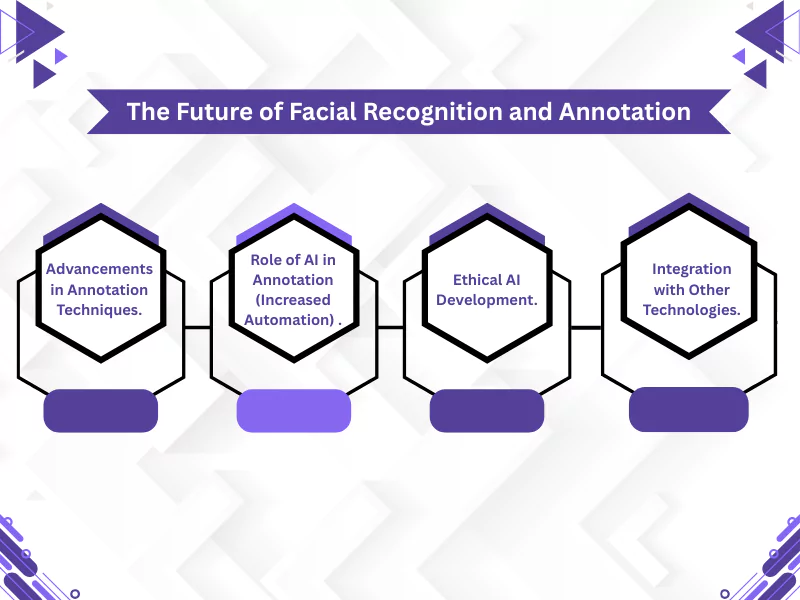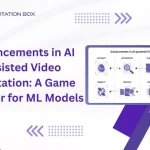Machines and AI do not see faces in the human sense, but they are adept at identifying humans using unique facial features. Your phone also uses these principles to recognize your face and unlock it.
That brings us to the question: What does it take for AI to recognize faces and function properly? The answer lies in high-quality image annotation, the backbone of strong facial recognition systems.
This blog will guide you through the impact of high-quality image annotation on facial recognition AI, explore the significance of image annotation from the perspective of AI facial recognition, and more.
Before delving deep into the impact of image annotation, it is important to understand the two concepts and how one helps the other.
A. Facial Recognition
As mentioned, machines do not see faces like humans. They can identify and verify individuals based on numerous unique facial features. They detect faces, analyze features, and compare them against a database of known faces or a reference face to deliver appropriate results.
The entire process can be broken down into three steps, namely:
➞ Face detection – The first step is to locate a face, or multiple faces, within an image or video frame.
➞ Feature extraction – Face analysis to identify and map unique facial landmarks and features. (e.g., distance between eyes, nose shape, jawline, etc.)
➞ Face comparison/identification – Comparing the faces against a database to find a match and verify the identity.
➞ Real-world applications – Smartphone unlock, airport security, law enforcement, retail analytics, etc.
B. Image Annotation
Image annotation is all about labeling or tagging images to train machine learning models. The process is significant in the facial recognition process since it involves marking and identifying facial features.
Types of image annotation – The different types of annotation for facial recognition AI include:
◆ Bounding box annotation
◆ Keypoint (landmark) annotation
◆ Attribute annotation (optional but powerful)
It is important to understand that facial recognition cannot function without proper image annotation techniques. Annotation should not be considered a preprocessing step; it provides the primary data that fuels the intelligence.
With that understanding of how annotated facial images improve machine learning, we will move on and understand how the quality of annotation has a direct impact on facial recognition AI.
The Ripple Effect: How Annotation Quality Shapes Facial Recognition Outcomes
1. How High-Quality Annotation Improves AI Performance
High-quality annotation can be defined as providing precise, consistent, and truly representative data to AI models. The following points will help you learn the ‘how’ better:
a. Data Labeling Accuracy and Precision
Annotating specific features in images helps AI understand and detect these features in new images, irrespective of lighting, angle, or expression variation. Accurate annotation helps develop more reliable facial recognition systems. It is crucial for applications like security, authentication, and social media.
High-quality annotation can help AI learn to see faces with exceptional clarity. Here’s how this can be achieved:
➞ Pinpoint delineation – Bounding boxes can perfectly frame faces with keypoints (such as eye corners or nose tips) placed accurately. This helps AI learn the exact geometry and boundaries of the face.
➞ Fewer errors – Precision helps reduce false positives and false negatives.
◆ A false positive is when AI makes a mistake identifying someone
◆ A false negative is when AI cannot recognize the person it should
➞ Real-world reliability – High-quality annotation implies that the AI is trained on a wide range of scenarios. The training datasets include varied lighting conditions, different angles, diverse facial expressions, and common occlusions like glasses or masks. Such comprehensive and accurately labeled data helps AI become more robust. As a result, it performs consistently and reliably in unpredictable complexities in the real world.
b. Bias Mitigation and Fairness
The quality of annotation helps build ethical and equitable facial recognition systems. This, in turn, helps combat inherent algorithmic biases actively.
➞ Addressing the bias problem – Algorithmic bias in facial recognition is normally a result of unrepresentative or unbalanced training data. For example, if the dataset features one demographic group predominantly, the AI will perform less accurately for others.
➞ The annotation solution – The only way to solve this problem is by creating diverse and carefully balanced datasets. This implies intentionally collecting and cautiously annotating images to present a balanced dataset. It must represent all demographics for the AI to remove algorithmic biases and perform well.
➞ Fair guidelines – It is crucial to implement fair guidelines to ensure that human annotators label all the images consistently across all groups. This also means that the annotators prevent unconscious human biases while working on the data.
c. Enhanced Model Efficiency and Generalization
Well-annotated and clean data improve the AI training process. Consequently, it helps make the system more adaptable.
➞ Faster learning – Accurate data helps AI models learn quickly and efficiently. They converge faster, which implies that they can reach optimal performance in fewer training cycles, thus saving a lot of computational resources and time.
➞ Reduced rework – The precise and accurate initial data saves developers from reworking the AI models. They spend less time debugging, fixing errors, or retraining models.
➞ Stronger adaptability – AI models trained on high-quality, representative data help them gain stronger generalization capabilities. The models can perform well even on new faces or in scenarios where it is not been trained yet, making it more effective.
2. The Downside: How Low-Quality Annotation Cripples Facial Recognition
It is crucial to understand both aspects before working on datasets. Neglecting the quality of annotation can result in a lot of problems in training AI models. Here’s a detailed breakdown:
a. Inaccuracies and Unreliability
Inaccurate, inconsistent, or poorly defined annotation results lead to a flawed and untrustworthy facial recognition system.
➞ Frequent mistakes – The AI models will continuously make errors, thus leading to misidentifications or failure to detect faces altogether.
➞ High error rates – Inaccurate and inconsistent annotated data can significantly increase false positives and false negatives.
➞ Fragile performance – AI models trained on flawed data cannot function correctly in real-world conditions.
b. Amplification of Bias and Ethical Problems
Low-quality annotation goes beyond reflecting existing bias and often amplifies it, leading to severe real-world harm.
➞ Reinforcing stereotypes – If the training data is poorly labeled for certain groups, the AI will continue learning those imbalances. As a consequence, the model will perform worse for these underrepresented populations.
➞ Real-world harm – The entire process has ethical and societal implications. Biased systems can lead to wrongful arrests, discriminatory access to services, unfair surveillance practices, or exclusion of marginalized communities, hampering public trust.
c. Waste of resources and stunted development
Training AI with low-quality data is a costly, inefficient, and fruitless endeavor.
➞ Soaring costs – Flawed data often needs more training iterations, longer processing times, and great computational power, thus increasing training costs in both time and hardware.
➞ Endless rework – Developers often spend a lot of time debugging, correcting annotations manually, and continuously retraining data as compensation.
➞ Project failure – There might be situations where the facial recognition system cannot be deployed due to low-quality data, thus leading to financial losses.
All of these suggest that high-quality image annotation is not just a technical requirement; it is a fundamental need to build facial recognition AI that is accurate, fair, reliable, and trustworthy.
Best Practices for High-Quality Facial Image Annotation
It is crucial to implement the best practices for high-quality image annotation. Let’s take you through them one by one:
➞ Clear and comprehensive guidelines – Developing detailed instructions for annotators, covering edge cases and specific destinations.
➞ Trained and expert annotators – Human annotators with domain knowledge and proper attention to detail.
➞ Robust quality assurance
◆ Multiple reviewers – Applying a system of checks and balances with multiple annotators reviewing each other’s work.
◆ Consensus mechanisms – Using the right techniques to make sure annotators agree on difficult cases.
◆ Benchmarking/gold standard datasets – Comparing the results against a pre-defined ‘gold standard’ for accuracy.
➞ Annotation tools and platforms
◆ Specialized software – Using the right tools necessary for facial landmarking and segmentation.
◆ AI-assisted annotation – Using AI to pre-label data and then sending it to human annotators for refining it for speed and accuracy.
➞ Data diversity and augmentation
Collecting diverse data – Actively collecting images that represent a wide range of demographics and conditions.
◆ Synthetic data generation – Creating AI to supplement real datasets and address scarcity or bias.
Implementing these properly can help get high-quality image annotation for facial recognition AI in computer vision technology.
The Future of Image Annotation on Facial Recognition AI

Facial recognition and the process behind it, data annotation, is ever evolving, all due to technological leaps and evolving societal demands. We can expect these trends to shape up these powerful technologies and re-discover the ways it is used:
1. Advancements in Annotation Techniques:
Facial recognition is moving beyond basic identification and is shaping up to understand deeper nuances
- 3D Facial Reconstruction from 2D Images – Presently, facial recognition works on 2D images. It is expected that in the future, the process will be able to reconstruct full 3D facial models from single or multiple 2D images. This will help AI understand a face’s geometry, thus making it more robust.
Annotation will have a major role to play in the process. Instead of using bounding boxes or 2D keypoints, annotators will need to mark hundreds or even thousands of 3D landmarks.
- Dynamic Facial Expressions and Micro-expressions – Facial recognition will play a major role in recognizing not just faces, but their emotional state. It will involve recognizing dynamic facial expressions and even fleeting, involuntary micro-expressions.
Frame-by-frame video annotation is necessary to help AI models learn specific ‘Action Units.’ This will need annotators who have the right understanding of human psychology and physiology, along with the tools needed to make it possible.
2. Role of AI in Annotation (Increased Automation)
The growing demand for vast, high-quality datasets for facial recognition will require more efficient annotation processes. Here, AI itself will play a major role in accelerating annotation for more scalability.
The process will require AI-assisted annotation or automated image labeling. AI models can generate rough bounding boxes, keypoints, or even initial 3D models. Human annotators can refine, correct, and validate these AI-generated labels. The ‘human-in-the-loop’ process will make things possible.
3. Ethical AI Development:
With facial recognition becoming more universal, the ethical implications, such as bias, privacy, and potential misuse, are high. The future will place more emphasis on building AI systems that are fair, transparent, and respectful of individual rights.
This means curating training datasets to ensure diversity across demographics to reduce algorithmic bias. Annotators must get clear guidelines to remove unconscious biases from influencing biases.
4. Integration with Other Technologies
Future facial recognition will go beyond simple facial recognition and combine multiple biometric modalities to enhance accuracy, security, and robustness. The multi-modal AI will be able to combine facial data with voice recognition, how a person walks, iris scans, or even physiological signals.
Multi-modal annotation is the core requirement to make it possible. Instead of annotating images in isolation, future annotations will need to correlate and synchronize labels across different data types. It will help create richer, more comprehensive datasets, allowing AI to build a holistic understanding of an individual.
Final Thoughts,
High-quality image annotation is the basic requirement for a robust facial recognition system. The entire system depends on how well the data annotators work and share properly annotated data. That said, continuous change is essential, considering the technological evolution and the need for more robust systems for a better facial recognition process.
- How Image Annotation Improves AI Model Accuracy and the Role of AI Model Training? - October 20, 2025
- Types of Data Classification and How They Protect Sensitive Information - September 18, 2025
- The Impact of High-Quality Image Annotation on Facial Recognition AI - July 21, 2025






